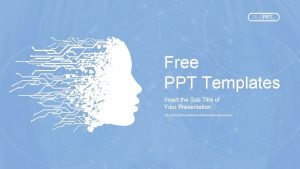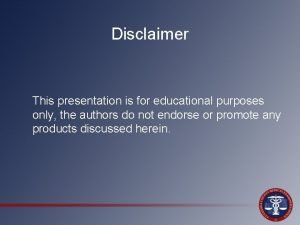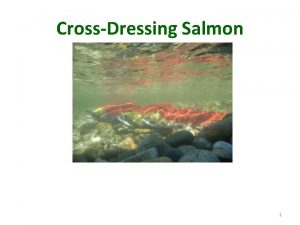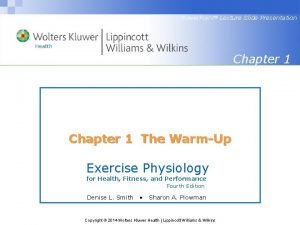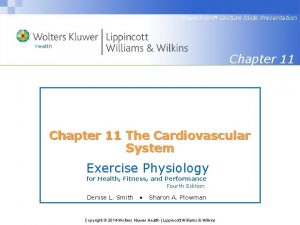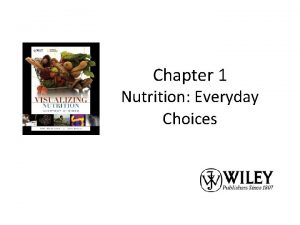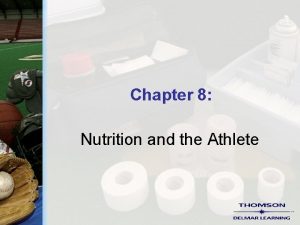Power Point Lecture Slide Presentation Chapter 6 Nutrition




























- Slides: 28

Power. Point® Lecture Slide Presentation Chapter 6 Nutrition for Fitness and Athletics Exercise Physiology for Health, Fitness, and Performance Fourth Edition Denise L. Smith • Sharon A. Plowman Copyright © 2014 Wolters Kluwer Health | Lippincott Williams & Wilkins

Chapter 6 Nutrition for Fitness and Athletics I. Introduction A. Optimal nutrition for fitness and athletics relates to 2 distinct situations 1. Training 2. Competition Copyright © 2014 Wolters Kluwer Health | Lippincott Williams & Wilkins

Chapter 6 Nutrition for Fitness and Athletics II. Nutrition and Training A. Goals of optimal training diet 1. To provide caloric and nutrient requirements 2. To incorporate nutritional practices that promote good health 3. To achieve and maintain optimal body composition and playing weight Copyright © 2014 Wolters Kluwer Health | Lippincott Williams & Wilkins

Chapter 6 Nutrition for Fitness and Athletics 4. To promote recovery from training sessions and physiological adaptations 5. To try variations of precompetition and competition fuel and fluid intake to determine the body’s responses Copyright © 2014 Wolters Kluwer Health | Lippincott Williams & Wilkins

Chapter 6 Nutrition for Fitness and Athletics Copyright © 2014 Wolters Kluwer Health | Lippincott Williams & Wilkins

Chapter 6 Nutrition for Fitness and Athletics Copyright © 2014 Wolters Kluwer Health | Lippincott Williams & Wilkins

Chapter 6 Nutrition for Fitness and Athletics B. Kilocalories 1. The most obvious distinction between active and inactive individuals is the number of calories required per day 2. Everyone needs sufficient calories to support daily needs, and children need adequate calories for growth 3. Athletes may consume between as many as 9, 000 -11, 000 kcal. day Copyright © 2014 Wolters Kluwer Health | Lippincott Williams & Wilkins

Chapter 6 Nutrition for Fitness and Athletics C. Carbohydrate – important facts: - The higher the intensity of exercise, the more important glycogen is as a fuel - Training increases the ability to store carbohydrate and to spare carbohydrate - Fatigue, “hitting the wall, ” and exhaustion are tied to glycogen depletion during high intensity, long-duration activity Copyright © 2014 Wolters Kluwer Health | Lippincott Williams & Wilkins

Chapter 6 Nutrition for Fitness and Athletics 1. Glycemic Index - A measure that compares the elevation in blood glucose caused by the ingestion of 50 g of any CHO food with the elevations caused by 50 g of white bread Copyright © 2014 Wolters Kluwer Health | Lippincott Williams & Wilkins

Chapter 6 Nutrition for Fitness and Athletics 2. Glycogen Resynthesis 5 -6% per hour under optimal conditions Copyright © 2014 Wolters Kluwer Health | Lippincott Williams & Wilkins

Chapter 6 Nutrition for Fitness and Athletics 3. Glycogen Sources a. Sports drinks b. Sports bars c. Sports gels Copyright © 2014 Wolters Kluwer Health | Lippincott Williams & Wilkins

Chapter 6 Nutrition for Fitness and Athletics Copyright © 2014 Wolters Kluwer Health | Lippincott Williams & Wilkins

Chapter 6 Nutrition for Fitness and Athletics D. Protein US RDA of protein - Adults = 0. 8 g • kg-1 - Ages 7 -10 yr = 1. 2 g • kg-1 - Ages 11 -14 yr = 1. 0 g • kg-1 - Ages 15 -18 yr = 0. 9 g • kg-1 Copyright © 2014 Wolters Kluwer Health | Lippincott Williams & Wilkins

Chapter 6 Nutrition for Fitness and Athletics Do athletes need more protein? 1. Resistance training - 1. 2 -2. 0 g • kg • day - 15% of total calories 2. Endurance training - 1. 2 -1. 4 g • kg-1 • day Sports Anemia - A transient decrease in red blood cells and hemoglobin Copyright © 2014 Wolters Kluwer Health | Lippincott Williams & Wilkins

Chapter 6 Nutrition for Fitness and Athletics E. Fat - Major fuel for exercise of low to moderate intensity Copyright © 2014 Wolters Kluwer Health | Lippincott Williams & Wilkins

Chapter 6 Nutrition for Fitness and Athletics F. Vitamins - Organic substances of plant or animal origin which are essential for normal growth, development, metabolic processes and energy transformations No evidence that supplementation is beneficial in adequately nourished individuals Copyright © 2014 Wolters Kluwer Health | Lippincott Williams & Wilkins

Chapter 6 Nutrition for Fitness and Athletics G. Minerals - Elements not of animal or plant origin which are essential constituents of all cells and of many functions in the body 1. Microminerals 2. Macrominerals Copyright © 2014 Wolters Kluwer Health | Lippincott Williams & Wilkins

Chapter 6 Nutrition for Fitness and Athletics III. Nutrition Competition Goals for optimal competitive diet 1. To ensure adequate fuel supplies in the pre-event time span 2. To ensure adequate fuel supplies during the event, no matter what the event 3. To facilitate temperature regulation by preventing dehydration Copyright © 2014 Wolters Kluwer Health | Lippincott Williams & Wilkins

Chapter 6 Nutrition for Fitness and Athletics 4. To achieve desired weight classifications while maintaining fuel and water supplies 5. To avoid gastrointestinal discomfort during competition Copyright © 2014 Wolters Kluwer Health | Lippincott Williams & Wilkins

Chapter 6 Nutrition for Fitness and Athletics A. Carbohydrate Loading (Glycogen Supercompensation) - A process of nutritional modification that results in an additional storage of glycogen in muscle fiber that can be approxi-mately 3 to 4 times the normal levels Copyright © 2014 Wolters Kluwer Health | Lippincott Williams & Wilkins

Chapter 6 Nutrition for Fitness and Athletics Copyright © 2014 Wolters Kluwer Health | Lippincott Williams & Wilkins

Chapter 6 Nutrition for Fitness and Athletics B. Pre-Event Meal C. Feeding during Exercise - to maintain blood glucose levels and prevent fatigue D. Fluid Ingestion during and after Exercise Copyright © 2014 Wolters Kluwer Health | Lippincott Williams & Wilkins

Chapter 6 Nutrition for Fitness and Athletics Copyright © 2014 Wolters Kluwer Health | Lippincott Williams & Wilkins

Chapter 6 Nutrition for Fitness and Athletics IV. Eating Disorders A. Definitions Anorexia Nervosa - An eating disorder characterized by marked self-induced weight loss accompanied by an intense fear of fatness and reproductive hormonal changes Bulimia Nervosa - An eating disorder marked by an unrealistic appraisal of body weight and/or shape that is manifested altering bingeing and purging behavior Copyright © 2014 Wolters Kluwer Health | Lippincott Williams & Wilkins

Chapter 6 Nutrition for Fitness and Athletics Anorexia Athletica - An eating disorder occurring primarily in young, female athletes that is characterized by a food intake less than that required to support the training regimen and by body weight no more than 95% of normal Copyright © 2014 Wolters Kluwer Health | Lippincott Williams & Wilkins

Chapter 6 Nutrition for Fitness and Athletics Copyright © 2014 Wolters Kluwer Health | Lippincott Williams & Wilkins

Chapter 6 Nutrition for Fitness and Athletics B. Risk factors 1. Dieting at an early age 2. Unsupervised dieting 3. Lack of acceptance of pubertal changes 4. Early sport-specific training 5. A large increase in training volume accompanied by a significant weight loss 6. Traumatic events Copyright © 2014 Wolters Kluwer Health | Lippincott Williams & Wilkins

Chapter 6 Nutrition for Fitness and Athletics C. Consequences D. Prevention and Treatment Copyright © 2014 Wolters Kluwer Health | Lippincott Williams & Wilkins
 Heel toe polka dance steps
Heel toe polka dance steps Free power point slide
Free power point slide 01:640:244 lecture notes - lecture 15: plat, idah, farad
01:640:244 lecture notes - lecture 15: plat, idah, farad Power point presentation topic in hindi
Power point presentation topic in hindi Power point presentation design west vancouver
Power point presentation design west vancouver The real lesson 21
The real lesson 21 Power bi power point
Power bi power point Point point power
Point point power Lecture presentation software
Lecture presentation software Power system dynamics and stability lecture notes
Power system dynamics and stability lecture notes Power system analysis lecture notes
Power system analysis lecture notes Power semiconductor devices lecture notes
Power semiconductor devices lecture notes Switch mode power supply lecture notes
Switch mode power supply lecture notes Power system dynamics and stability lecture notes
Power system dynamics and stability lecture notes Traditions in things fall apart
Traditions in things fall apart Factoring slide and divide method
Factoring slide and divide method Presentation outline slide
Presentation outline slide Housekeeping slide for presentation
Housekeeping slide for presentation Maijdee balika bidyaniketan
Maijdee balika bidyaniketan Allppt layout clean text slide for your presentation
Allppt layout clean text slide for your presentation Allppt layout clean text slide for your presentation
Allppt layout clean text slide for your presentation Allppt layout clean text slide for your presentation
Allppt layout clean text slide for your presentation Change colors of image
Change colors of image Allppt layout clean text slide for your presentation
Allppt layout clean text slide for your presentation Disclaimer for educational purposes
Disclaimer for educational purposes Acknowledgement for assignment
Acknowledgement for assignment Allppt layout clean text slide for your presentation
Allppt layout clean text slide for your presentation Which statement best describes a good presentation slide?
Which statement best describes a good presentation slide? Final presentation slide
Final presentation slide























